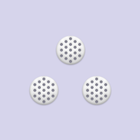Colloidal silica (silicon dioxide) nanoparticles are an important class of nanomaterials with hundreds of thousands of tons produced annually for a wide range of applications including abrasives, sorbents, catalysis, filtration, electronics, textiles and fabrics, and paints and coatings. At nanoComposix, we offer a selection of silica nanomaterials as standard products, including solid silica nanoparticles, mesoporous silica nanoparticles, and silica shelled metal nanoparticles. We are highly skilled at modifying silica surfaces and fabricating a variety of silica morphologies on a custom basis.
Silica Nanoparticle Table of Contents:
- Introduction & Overview
- Physical Properties
- Mesoporous Silica
- Applications of Silica
- Silica FAQ
- Buy Related Products ❯
The TEM images below provide examples of some of the different silica varieties that have been produced in our labs at nanoComposix.

These images feature 500 nm hollow silica nanoparticles (upper left), 500 nm solid silica nanoparticles with mesoporous shells (upper right), 300 nm solid silica nanospheres (lower left), 100 nm mesoporous silica nanoparticles with radial pores (lower right), and silver nanocubes coated with silica shells (center). Check out our standard products or visit our contact us page to learn more about our silica product offerings.
Background
Silica nanoparticles are biocompatible, thermally stable, low cost, have low toxicity, and their surfaces can be easily modified. Silica nanoparticles are typically spherical with highly uniform size and shape, but they can also be produced in a variety of different shapes and sizes or applied as surface coatings to other types of nanomaterials. The size, porosity, crystallinity, and shape of silica nanoparticles can be precisely engineered, allowing for silica-based nanomaterials to be optimized for the variety of applications listed above, and more.
Silica surfaces can be easily modified with hundreds of available of silanes to control surface chemistry, drug loading, solvent compatibility, stability and to allow for site-specific biological targeting. Silica can be used to encapsulate virtually all types of nanoparticles with nanometer level precision. The silica surface is robust and silica-coated nanoparticles can be concentrated to very high levels.
Making Silica & Silica Coated Nanoparticles
Silica nanoparticles are fabricated via the condensation of silanes to form nanoparticles composed of an amorphous network of silicon and oxygen. This technique, known as the Stöber method,1 was developed over 50 years ago and remains the most commonly used method to synthesize colloidal silica nanoparticles. Improvements to the basic technique enable production of the high-quality silica materials we make here at nanoComposix. In this reaction, an alkyl silicate reacts with water in an alcoholic solution. In the presence of ammonia as a catalyst, small silicate molecules join via aggregation to form larger clusters of molecules. This method can be used to generate silica particles up to 2 µm in diameter and to encapsulate a wide variety of metal and metal-oxide nanoparticles. The size of the resultant silica particles can be easily tuned by changing the reactions conditions and the surface can be modified by introducing different silanes at various times during the reaction. For more information about size control of silica nanoparticles, click here. Interestingly, this same method is used to grow silica shells onto metal nanospheres in a highly controlled and reproducible manner.2 For more information about nanoparticle cores coated with silica, click here.
References
- Stöber, W.; Fink, A.; Bohn, E. Controlled Growth of Monodisperse Silica Spheres in the Micron Size Range. J. Colloid Interf. Sci. 1968, 26, 62-69.
- Liz-Marzán, L. M.; Giersig, M.; Mulvaney, P. Synthesis of Nanosized Gold-Silica Core-Shell particles. Langmuir 1996, 12, 3429-4335.



